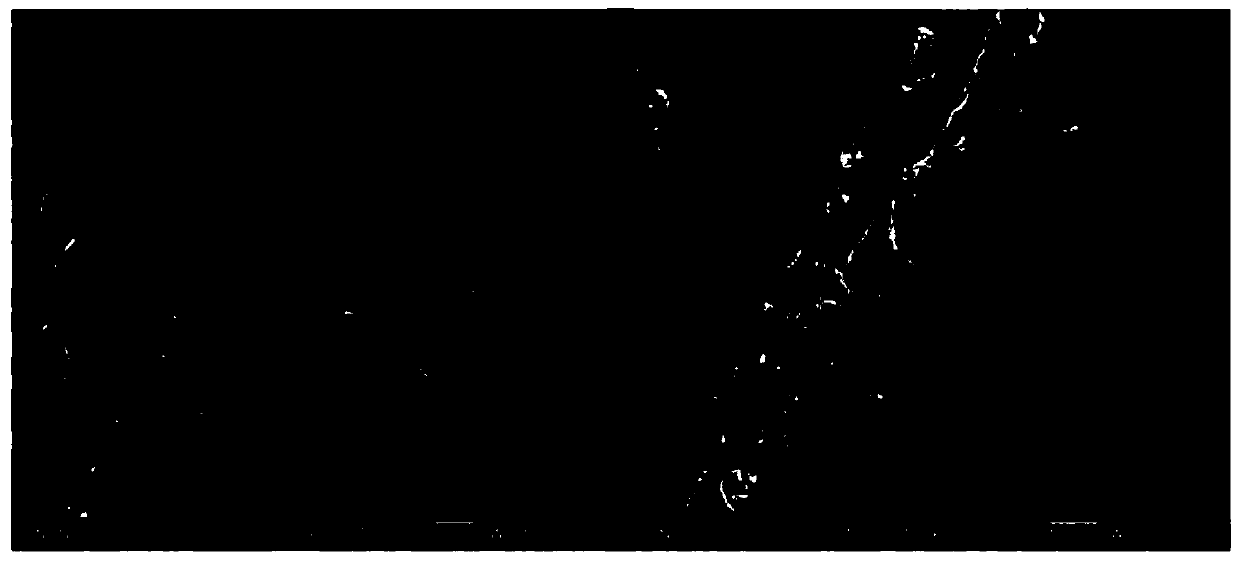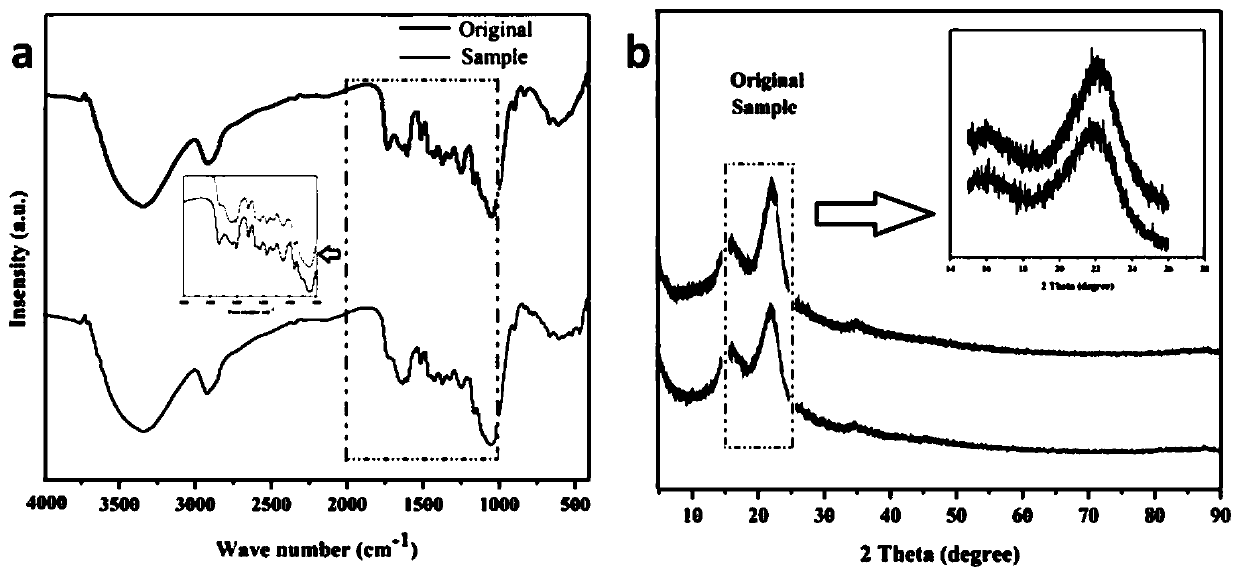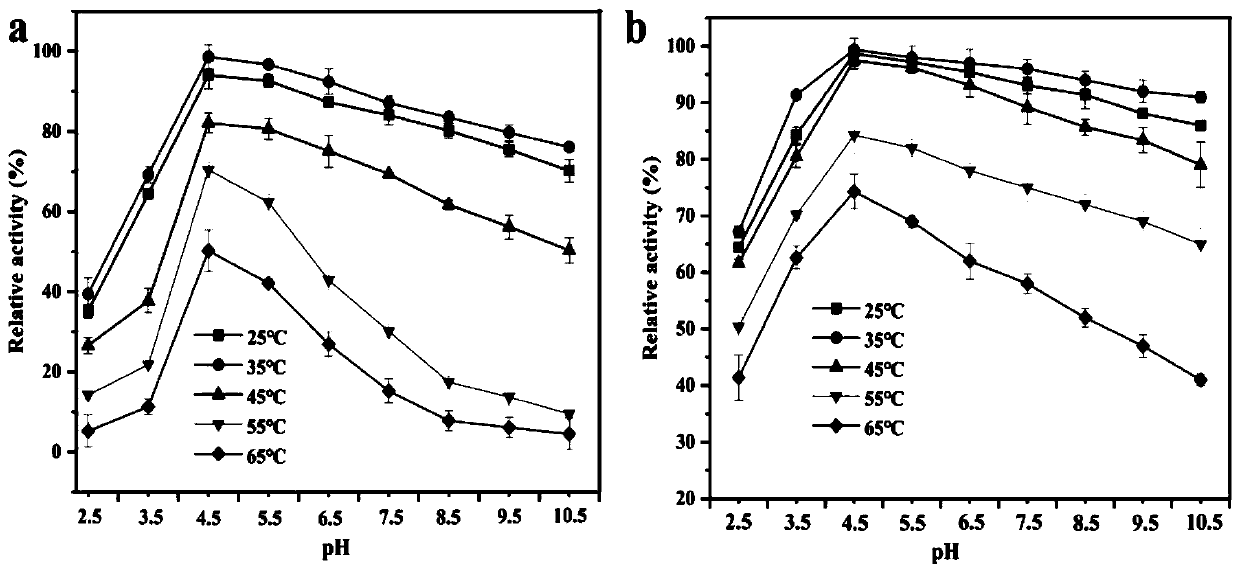Method for degrading corn straws
A technology of corn stalks and magnetic nanoparticles, applied in biochemical equipment and methods, fixed on or in inorganic carriers, fixed on/in organic carriers, etc. High production cost, deformation and inactivation, etc., to improve activity and stability, ensure cellulase activity, and increase affinity
- Summary
- Abstract
- Description
- Claims
- Application Information
AI Technical Summary
Problems solved by technology
Method used
Image
Examples
Embodiment 1
[0045] A method for degrading corn stalks, comprising the following steps:
[0046] (1) After the corn stalks are mechanically crushed, pass through a 40-mesh sieve, and then dry at 105° C. for later use;
[0047] (2) Cu 2+ Modified Fe 3 O4-NH 2 -PEI magnetic nanoparticles were dissolved in NaAC-HAC buffer solution containing laccase, and treated with shaking at 150 rpm for 40min at 25°C; after the reaction, the prepared Cu 2+ Modified Fe 3 O4-NH 2 - PEI laccase magnetic nanoparticles and supernatant separation; ultrapure water for Cu 2+ Modified Fe 3 O4-NH 2 -PEI laccase magnetic nanoparticles were washed continuously until no laccase activity was detected in the detergent; the pH of NaAC-HAC buffer was 4.6, the concentration of laccase was 0.5mg / mL, Cu 2+ Modified Fe 3 O4-NH 2 -The mass volume ratio of PEI magnetic nanoparticles to NaAC-HAC buffer solution is 1mg: 10mL;
[0048] (3) Shake the immobilized laccase prepared in step (2), the corn stalks treated in ste...
Embodiment 2
[0052] A method for degrading corn stalks, comprising the following steps:
[0053] (1) After the corn stalks are mechanically crushed, pass through a 40-mesh sieve, and then dry at 105° C. for later use;
[0054] (2) Immobilize laccase on Cu 2+ Modified Fe 3 O4-NH 2 -On PEI magnetic nanoparticles, immobilized laccase was formed, specifically Cu 2+ Modified Fe 3 O4-NH 2 -PEI magnetic nanoparticles were dissolved in NaAC-HAC buffer solution containing laccase, and shaken at a rate of 150 rpm for 70 min at 25°C; after the reaction, the prepared Cu 2+ Modified Fe 3 O4-NH 2 - PEI laccase magnetic nanoparticles and supernatant separation; ultrapure water for Cu 2+ Modified Fe 3 O4-NH 2 -PEI laccase magnetic nanoparticles were washed continuously until no laccase activity was detected in the detergent; the pH of NaAC-HAC buffer was 4.6, the concentration of laccase was 4mg / mL, Cu 2+ Modified Fe 3 O4-NH 2 -The mass volume ratio of PEI magnetic nanoparticles to NaAC-HAC b...
Embodiment 3
[0059] A method for degrading corn stalks, comprising the following steps:
[0060] (1) After the corn stalks are mechanically crushed, pass through a 40-mesh sieve, and then dry at 105° C. for later use;
[0061] (2) Immobilize laccase on Cu 2+ Modified Fe 3 O4-NH 2 -On PEI magnetic nanoparticles, immobilized laccase was formed, specifically Cu 2+ Modified Fe 3 O4-NH 2 -PEI magnetic nanoparticles were dissolved in NaAC-HAC buffer solution containing laccase, and shaken at a rate of 150 rpm for 50 min at 25°C; after the reaction, the prepared Cu 2+ Modified Fe 3 O4-NH 2 - PEI laccase magnetic nanoparticles and supernatant separation; ultrapure water for Cu 2+ Modified Fe 3 O4-NH 2 - PEI laccase magnetic nanoparticles were washed continuously until no laccase activity was detected in the detergent; the pH of NaAC-HAC buffer was 4.6, the concentration of laccase was 20.5 mg / mL, Cu 2+ Modified Fe 3 O4-NH 2 -The mass volume ratio of PEI magnetic nanoparticles to NaAC-...
PUM
 Login to View More
Login to View More Abstract
Description
Claims
Application Information
 Login to View More
Login to View More - R&D
- Intellectual Property
- Life Sciences
- Materials
- Tech Scout
- Unparalleled Data Quality
- Higher Quality Content
- 60% Fewer Hallucinations
Browse by: Latest US Patents, China's latest patents, Technical Efficacy Thesaurus, Application Domain, Technology Topic, Popular Technical Reports.
© 2025 PatSnap. All rights reserved.Legal|Privacy policy|Modern Slavery Act Transparency Statement|Sitemap|About US| Contact US: help@patsnap.com



